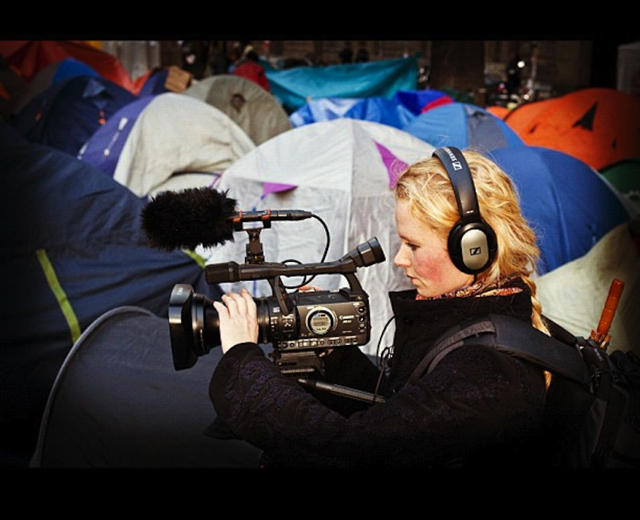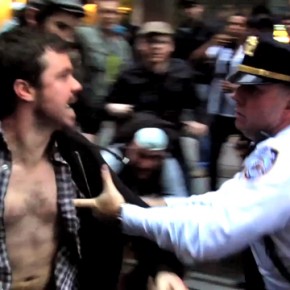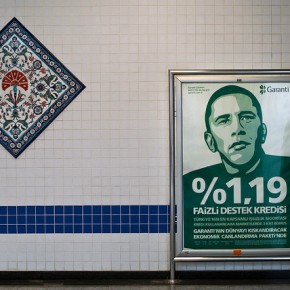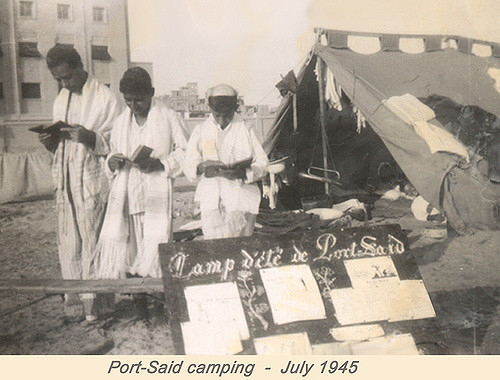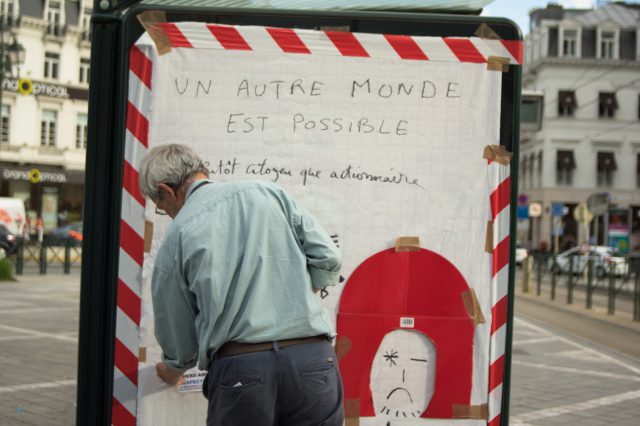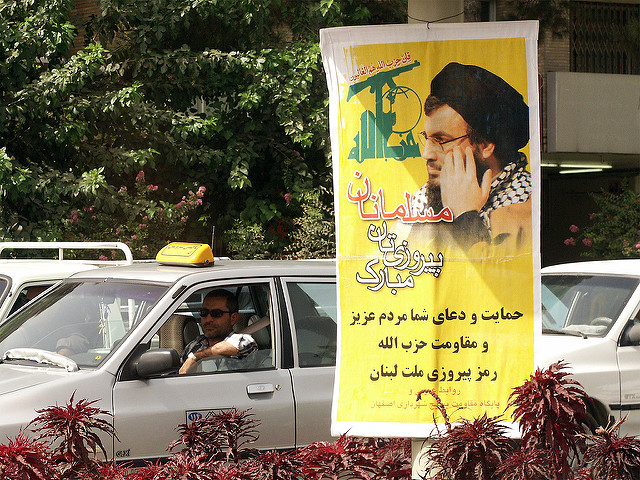Hashtags were prominent, whether in the below screen titles, or in the title of the films themselves. ##12M mai no hem marxat (15Mbcn.tv) provided a birds-eye-view of Plaça Catalunya on the first anniversary of the 15 May protests that launched the Indignados movement (and inspired OWS.) The title means “We have not left.” With the hashtag, it refers not only to the use of social media in movements, but the Twitter message that went out that day, reminding the world that this was not over. The producers of this short, as it turns out, have been documenting the plaza, with attention to social activities and the crackdowns on activism.
Handwritten signs provided a powerful reminder of small, analogue media that combat the messages from above. “Fox News will Lie About this,” read one poster in Wisconsin Budget Repair Bill Protest (Shahin Izadi) which depicted the occupation of the Madison capitol building in protest of the devastating attack on collective bargaining and public services. In Sarah Blom’s feature Fair Square: Occupy Amsterdam, scraps of paper and poster bearing slogans are shown pasted onto Beursplein 5 (the Dutch Stock Exchange.) Conceptual and physical space is occupied in these media actions.
Many films could represent this clash of media narratives through the editing of copious footage, whether from citizen journalists (and uploaded onto YouTube as suggested by the blurred and highly pixelated grain that reminds us of the difference in video registers) or from alternative media outlets such as Al Jazeera, Russia Today (a curious but interesting spot for news, I find), and Occupy TVNY, an open video collective who produced festival entry Voices of Veterans.
Most powerful in this selection may have been I am Not Moving (Corey Ogilvie) combines a historical and transnational perspective as he places OWS in a long line of protests—not just Arab Spring, but Tiananmen Square and the Civil Rights movement in the U.S. The film generates its emotional power from associative editing. The matched compositions of depictions of military and police force join the disparate battle. But more notable were the intercut sequences of Hilary Rodham Clinton and Barack Obama decrying the military force against protesters of Arab Spring with images of police violence against peaceful Occupy protesters (including the famous pepper-spraying of students in Oakland—an image repeated in many of the films). The irony in the juxtaposition calls to light a shared struggle and the hypocrisy of a government whose practices harm its citizens.
This erosion or testing of boundaries seemed an omnipresent theme in the programming. Perhaps these were most playfully assailed through The Tax Dodgers (Z.S. Grant), or rather through the program around it. As Fawcett introduced the 8.30pm program, she was interrupted by a man in a baseball uniform for the team, The Tax Dodgers. He was holding a box, asking after something celebrating its first birthday, before he introduced the team and its all-star line-up including Bank of America and Verizon. These players were the tax dodgers, he explained, corporations who had paid few to no taxes, and their gift to the audience was: Nothing. The box was empty. (Calling attention to this particular financial sector malfeasance was a theme of many films, including the Sunday night feature, We’re Not Broke (Karin Hayes and Victoria Bruce), which outlines the widespread tax avoidance that results in a perception of empty public coffers and cuts to public service.)
Backed by the cheerleading squad who brandished hula-hoops (“The Loopholes”) they performed for the audience, singing popular American songs with lyrics rewritten to underscore corporate debt and criminality. This was enjoyable as a lead-in to the program, but when they appeared once again in a film chronicling the political theatre of Gan Golan, the audience cheered. Through the festival, a genuine connection had been forged between the audience and the people on-screen. This call to emotion had been present throughout the evening, and many audience members were pointing and whispering throughout as they recognized themselves or a friend in the protests depicted on screen, but this moment invited everyone into knowing someone onscreen.
This intermedial and multi-platform theme joined productively with that of multitude. I choose this word deliberately as a connection to the term used by Michael Hardt and Antonio Negri to refer to a collective social subject poised to take back territory and capital, having been deterritorialized and marginalized by an empire of global capitalism. An aesthetic of multitude was present not only in the intermediality, which united a variety of voices, but also in its attention to said voices. Jean Thevenin’s 99 Words in Zuccotti Park invites occupiers, speaking directly to the camera, to say one word that expresses what Occupy means to them. The result ranges although words like “human”, “love”, “equality” and “solidarity” repeat, bringing a sense of consensus to this diverse collective. One could argue that the presence of the “mic check” also brought this sense of collective consensus in the multitude. (The “mic check” is a practice of having the crowd in front repeat what the speaker says for the benefit of those in back; this practice also works to excite the crowd and generate a feeling of unity.) Even the festival embodied this aesthetic: There was no physical program giving us a list and schedule of films. The shorts ran and only by paying attention could we determine its topic.
The multitude was visible in the worldwide demonstrations onscreen. Beyond the Indignados and Arab Spring were The Greek Revolt (Brandon Jourdan/Marianne Maeckelbergh) about the protests against austerity measures; Casseroles – Montréal, 24 mai 2012 (Jérémie Battaglia,) a black and white film of the nightly pot and pan demonstrations done to protest the rise in tuition fees and a law restricting public protests, and Sarah Blom’s fair Square: Occupy Amsterdam, which documented in exceptional detail the encampment from start to finish, both good and bad bits. The consensus rule of her film was shown to be a noble experiment, but perhaps too messy and inefficient for the next steps of protest.
America was by no means forgotten. San Francisco, Oakland, and New York appeared, but films also drew attentions to actions and communities in unexpected places. Alejandra and David: Facing Foreclosure (Peter Leeman) was both poignant and inspiring. The documentary told the story of a couple who experienced wrongful foreclosure of their home, and the way the local community rallied to occupy their home and protest the eviction. A town, immigrant rights activists and Occupy Homes MN united and on screen demonstrated the power of a humane and human horizontal integration—a useful reminder for how we think of the Occupy movement post-decentralization. Indeed, many films showed the more local, focused actions that have come out of the movement such as: F* the Banks (Dan Scott McNair), a playful call to foreclose on banks; Default: The Student Loan Documentary (Serge Bakalian and Aurora Meneghello;); and We Are Farmers, We Grow Food for the People (Anthony Lappé.)
Occupying Paradise (Michelle Fawcett) and Queen Mother of Harlem (Adele Pham) deepened these portraits with reminders of communities who risked being forgotten. Fawcett’s film turns to Hawaii where the indigenous community has long understood “Occupy” in terms of the colonial project that lead to genocide, theft of resources, and oppression. At the same time, she points out, native communities have long been mobilizing for land rights and sustainable farming: these are activists with whom the movement could join, provided they respect indigenous aims. Queen Mother introduces Dr. Delois Blakely of 477 West 142St HDFC, which, for over three decades, has provided low-income housing to women and children. Having long-addressed housing injustice, she was delighted by the turnout in Zuccotti Park. These films, among the others, offered helpful reminders of the role of local community actions as a foundation and resource for continued protest.
Agitating for continued economic justice advocacy, American Autumn: An Occudoc outlines the demands of the Occupy movement, explaining the rationale for this seemingly amorphous and inchoate series of demonstrations. In this regard, its tone is clear and direct, if playful. Amidst interviews with and speeches by Occupy protagonists like Cornel West, Medea Benjamin, Naomi Klein, Richard Muhammed, José Martín and many more, director Dennis Trainor Jr. intertwines portraits of activists and actions as well as efficient itemisations of injustices. The latter offers a powerpoint aesthetic of sorts: slideshows of readily consumable data that illustrate profound discrepancy through the use of figures—numbers or cartoon people, whose numbers or sizes can also illustrate comparative statistics. These are often playful and use ironic 1950s style images or archival footage to lighten the mood around a serious subject.
The film is useful to be sure, and many laughed and applauded (or waggled their spirit fingers as apparently one does in Occupy spaces,) but I’ll confess it did not move me as much as the other films. Its politics aligned with my own, but the aesthetics suggested something less interesting than the almost anarchic intermediality and immersion in the multitude enabled by the others. It was effective, but not affective—at least not for me. Of course, there may be other factors informing my response: The director’s use of voiceover, his introduction (including an identification of himself as a suburban husband and father) recalled the work of Michael Moore and Jason Russell (of Kony 2012 fame) and thus struck me as edging towards narcissism rather than the personal. The slick style suggested masterful media savvy; it certainly seemed to appeal to those in the audience but it also seemed to replicate the commercial styles that create a sense of top-down instruction rather than an emotive eruption from the multitude.
Nevertheless, this clear outline may be just what is required at a time when we reflect on the movement and where it is headed. It cannot take the same shape it did last year—certainly not if we are to learn anything from the challenges shown in Occupy Amsterdam. And it is not, as we see from the other films, which show the horizontal spread of the movement into local community partnerships. The movement is neither over nor irrelevant and the festival program effectively demonstrates that.
If I take any quibble with the politics on display, it remains with how little those involved seem aware of economic rights. So often, throughout films in the festival, I heard that “education should be a right” or that “shelter should be a right” or that “healthcare should be a right”. Of course they should be rights. That’s why they are listed as such in the UN International Covenant on Economic, Social, and Cultural Rights. Although the use of “should” suggests the correct impulse in shifting the frame, it may be more useful to ask questions around implementation and enforcement, as these are what have stymied so many decision-makers to date.
See All Protest, No Porn for the first part of this review. Screenshot from Fair Square: Occupy Amsterdam. Published under a Creative Commons license.
